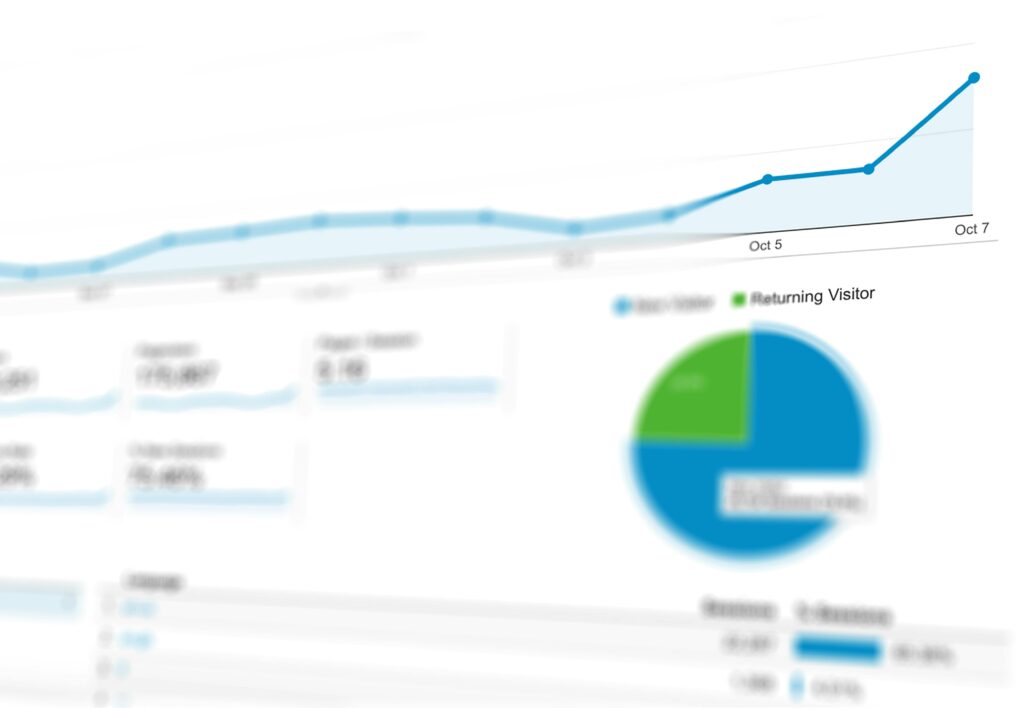What are website analytics and why should my business care about them?
For most businesses an online presence consists of a website, a Facebook page and maybe a few reviews on a Google Business Profile. Did you know you can track your website’s performance through free tools or paid tools? Part of “owning your data” is tracking your website’s performance and understanding what can be done to make it perform better. Here are a few key performance indicators we look for when we’re working with clients.
Organic sessions – these are individual visitors to a website who found the website naturally on the search engine results page. The visitor or “session” didn’t come from a paid ad, a social ad, another website, it came directly from the search results page. Also know as the number of users who found your website via organic search, this data can tell us how a website is being found and for what keywords.
Page Views- The number of times one of the pages on a website was viewed. This number can be higher than the sessions as a user can visit multiple pages in one session. This helps determine most popular pages or best performing content to attract new users.
Bounce rate – This refers to the number of visitors who visit the site and then leave within 10 seconds. If the user can’t quickly find an answer of what they were searching for the will quickly leave and go back to the search engine results page. These are important website analytics to track as a business could be losing sales.
Unique Events – Events can be monitored and tracked in analytics. An event could be the “click to call” button on a website or “click to email.”
Unique Goals – Goals can be set up to track things such as form fills. Goals can be set up within website analytics’ platforms in a variety of ways depending on the needs of the business.
These are just a few of the website analytics we monitor to help businesses stay on course for growth. There are, believe it or not, businesses who have no idea this can be done and are losing data that’s been built up over time.
If business owners and CEOs knew a website could work harder for them using website analytics it could create much growth for a business. If you knew where your digital audience was coming from, how would you change your message?
Website analytics are also very effective for tracking digital advertising campaigns. Utilizing tracking mechanisms such as Google Tag Manager or UTM codes ad campaigns can be monitored while they’re active. For instance if your social media ad campaign had a “tag” on the ads, within website analytics it can be tracked in “Direct Traffic.” The visitor came to the website directly from the ad on Facebook.
Another way to effectively use website analytics is A/B testing ad campaigns to test messaging and the ad design or “creative.” These sorts of tests can determine best media to use as well as saving money on ad spend. Why not get the max out of every advertising dollar by tracking ad campaigns with website analytics? At the end of the day it’s all about engagement and the time a consumer spent on a website. If users are coming to your website, you want them engaged in your content or continually browsing your inventory if you’re an ecommerce brand. If your content is boring, copied or thin, your engagement rates will go down.
Engagement rate is defined as “the amount of time a user spends on your webpage.” Engagement rates are another important aspect to monitor within your website analytics. This can be calculated by the “number of engaged sessions divided by the total number of sessions, multiplied by 100. If your engagement rates are low on different pages of a website it can signal that the content is weak or not answering the question related to the query by the user. There is software available that allows you to A/B test website content to determine which content drives the highest engagement rates. For some of our clients social media and organic search drive the highest engagement rates but will fluctuate depending on the content posted.
Collecting and interpreting website analytics is essential for all businesses in today’s world. Leaving website analytics to chance is like a roofer without a hammer. These are modern day business and marketing tools that can tell a business a lot about its consumers and audience. A business that runs digital ad campaigns without tracking performance in website analytics is running with a blindfold. Not having any idea how to optimize their campaigns or track which campaigns are driving revenue for them. Having the right tools and skills is imperative to getting it right. If you can’t, work with an agency like us who does.





